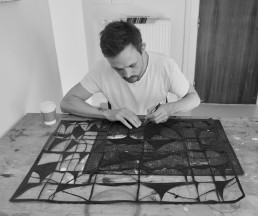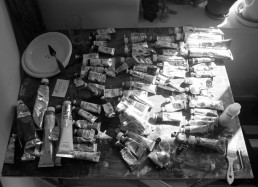“Changing one small component of a piece of art has a major influence on the rest of the composition.”
Interview with Mathias Malling Mortensen
Name: Mathias Malling Mortensen
Location: Copenhagen, Denmark
You just mentioned your grandfather, Richard Mortensen, who is one of the greatest artists in Denmark in the 20th century. How has it affected you as a person and as an artist?
I actually did not knew my grandfather, because he and my father did not talk together. However, I knew his works quite well through which I learned quite early to get familiar with the language of his pictures. Besides that, of course, I have read and studied a lot about my grandfather’s works. It also enabled me to dive into the inspirational sources he had, such as Kandinsky and Klee. Although my grandfather was very concrete in his expression, many of his shapes were based on what he saw and experienced. For example, it is interesting for me to look at a room, see shapes and put them into the context in which I work. Something else I’ve learned from my grandfather is about the process. He drew a lot of sketches for all his artworks. It was not just something that came out of the blue, he worked really in depth with his compositions. This working method has been very interesting and useful to me, especially when working as minimalistic as I do, the detail is very important. How a line is placed is extremely important for the whole artwork. That’s something I think is very exciting, every element of the picture is extremely important. Changing one small component of a piece of art has a major influence on the rest of the composition.


Can you tell about the process of making your artworks?
In the process of creation, I have a lot of sketchbooks with drawings and stuff. So when I’m going to make a piece of art, I have a starting point that I can relate to. Not that the work will be completely like the sketch, but I have a starting point. I have an ongoing process all the time, where the sketchbooks act as a kind of raw material, which I constantly feed in different ways. In the end, I have a material that can be translated into piece of art. But I never transmit it directly. It’s important that every artwork has an immediate line.
The art world represents a complex eco-system, comprised of a range of key players, each of which is dependent on each other. How do you, as an artist, navigate in this dynamic interplay?
There are many different players – galleries, collectors, curators, artists, art historians, etc. The most important thing, I guess, is to find people you like and people who inspire you. And it’s a bit the same on Instagram or other social media. Most of the people I have contact with on social media are also people I want to have contact with in reality. And fortunately, I have had the chance to meet a lot of them in reality. It offers a lot of new opportunities.
You have been selected by curator Shaka Loveless to make this year’s artwork for members of Artland Club – what are your thoughts about this way of engaging with a new audience?
I was really pleased to be asked by Shaka Loveless. It is exciting to show my artworks on a platform like Artland, but also to be able to work with lithographic artworks again. Usually that is something that requires a large setup.
It is also interesting that it is a musician who has asked me to be part of this, because of my relationship with music. The artworks that I will make for the members of Artland Club will in some way be an extension of the expression of my last solo exhibition at Sunday-S Gallery in Copenhagen. It was an exhibition based on music and the space between tones and the movement of a piece of music. That was what I tried to visualize in my works at the exhibition. So the new works I make for the members of the Artland Club will work on this expression – finding some kind of melody, finding rhythms and finding tones – but in a visual way.
About the artist
Mathias Malling Mortensen (b. 1980) works with paintings, paper cuts and graphics. He combines a craft-based surplus with artistic depth in a very original and aesthetic way.
The artist has recently exhibited at Sunday-S Gallery, Kunsthaus Essen, Charlotte Fogh Gallery, Les Gens Heureux and Printer’s Proof and he is featured in several prominent private collections.
